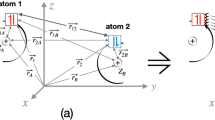Summary
The functional sensitivity densities δ ln σ12(E)/δ lnV ii (R) for He++Ne(2p 6)→He++Ne(2p 53s) reveal that the collisional excitation cross section σ12(E) is insensitive to the additional diabatic curveV 33 included in some models. The negligible sensitivity of σ12(E) toV 33 offers a quantitative validation of the more popular two state model for collisional excitation of Ne by He+. The sensitivity profiles for the collisional ionization Li+I→Li++I− modeled by crossing diabatic curvesV 11 (covalent) andV 22 (ionic) shows that the ionization cross section does not depend on inner crossings even when these stem from large distortions in the underlying potential energy curves. The lack of sensitivity to inner crossings establishes the predominant role of the outermost crossing in triggering nonadiabatic transitions.
Similar content being viewed by others
References
Rebentrost F (1981) In: Henderson D (ed) Theoretical Chemistry: Advances and Perspectives. Academic, New York; MS Child (1979) In: Bernstein RB (ed) Atom Molecule Collision Theory: A Guide for the Experimentalist. Plenum, New York; Tully JC (1976) In: Miller WH (ed) Dynamics of Molecular Collisions. Plenum, New York, Part B
Nakamura H (1991) Int Rev Phys Chem 10:123 and references therein
Nakamura H (1987) J Chem Phys 87:4031; Nakamura H (1984) J Phys Chem 88:4812
for example Wooley AM (1971) Molec Phys 22:207; Sink ML, Bandrauk D (1976) J Chem Phys 66:5313; Korsch HJ (1983) Molec Phys 49:325
Olson RE, Smith FT (1971) Phys Rev A 3:1607;
Braga JP, Dunne LJ, Murrell JN (1985) Chem Phys Lett 120:147;
Child MS, Gerber RB (1979) Mol Phys 38:421;
Eu BC, Tsien TP (1973) Phys Rev A 7:648
McLafferty FJ, George TF (1975) J Chem Phys 63:2609 and references therein; Laing JR, George TF (1977) Phys Rev A 16:1082; Cho U-I, Eu BC (1976) Molec Phys 32:1; (1976) 32:19; Eu BC, Zaritsky N (1979) J Chem Phys 70:4986
Shi S, Rabitz H (1989) Comp Phys Rep 10:1 and references therein
Padmavathi DA, Mishra MK, Rabitz H (1993) Phys Rev A48:279; Mishra M, Guzman R, Rabitz H (1987) Phys Rev A 36:1124
Padmavathi DA, Mishra MK, Rabitz H (1993) Phys Rev A 48:286
Padmavathi DA, Mishra MK, Rabitz H (1994) Chem Phys 179:469
Padmavathi DA, Mishra MK, Rabitz H (1994) Phys Rev A 50:3142
Faist MB, Levine RD (1976) J Chem Phys 64:2953
Author information
Authors and Affiliations
Rights and permissions
About this article
Cite this article
Padmavathi, D.A., Mishra, M.K. & Rabitz, H. A probe of dynamical models using functional sensitivity densities with application to He++Ne(2p 6)→He++Ne(2p 53s) and Li+I→Li++I− . Theoret. Chim. Acta 90, 323–329 (1995). https://doi.org/10.1007/BF01113539
Received:
Revised:
Accepted:
Issue Date:
DOI: https://doi.org/10.1007/BF01113539




